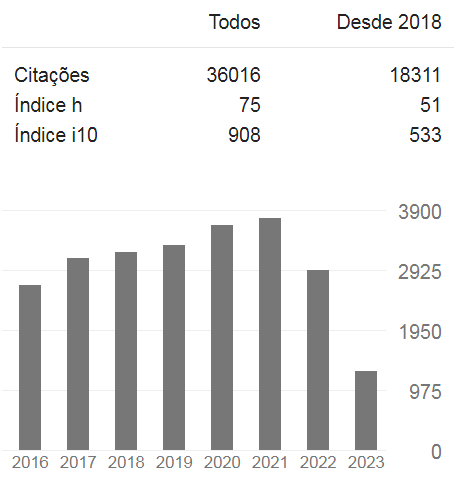Violência física ocupacional em serviços de urgência e emergência hospitalares
percepções de trabalhadores de enfermagem
DOI:
https://doi.org/10.5935/1415-2762.20170034Palavras-chave:
Enfermagem, Violência no Trabalho, Serviço Hospitalar de EmergênciaResumo
Objetivou-se desvelar as percepções de trabalhadores de enfermagem em relação à violência física ocupacional em serviços de urgência e emergência hospitalares. Estudo qualitativo desenvolvido por meio de 16 entrevistas individuais, cujos dados foram coletados entre março e maio de 2015 em dois hospitais de média complexidade, localizados no norte do Paraná. Para interpretação dos discursos adotaram-se análise de conteúdo e interacionismo simbólico como referenciais metodológico e teórico, respectivamente. Identificou-se que os atos agressivos foram perpetrados, em sua maioria, por pacientes e por profissionais de outras áreas da saúde, e suas motivações estavam intimamente relacionadas à maneira com que os envolvidos se comunicaram. Outro aspecto desvelado foram as reações dos trabalhadores de acordo com suas características pessoais e a maneira como desenvolveram o self (consciência de si mesmo). A compreensão da violência física ocupacional sob a perspectiva dos diferentes atores revelou sua complexidade e a importância do desenvolvimento de ações, não apenas por parte dos profissionais de enfermagem, mas pelas equipes multiprofissionais e intersetoriais, visando à prevenção e ao enfrentamento da violência ocupacional.
Referências
Cashmore AW, Indig D, Hampton SE, Hegney DG, Jalaludin BB. Factors influencing workplace violence risk among correctional health workers: insights from an Australian survey. Aust J Prim Health. 2015[cited 2017 Jan 26]22(5). Available from: http://dx.doi.org/10.1071/PY15071
Pai D, Lautert L, Souza SBC, Marziale MHP, Tavares JP. Violence, burnout and minor psychiatric disorders in hospital work. Rev Esc Enferm USP. 2015[cited in 2017 Jan. 26]49(3):457-64. Available from: http://dx.doi.org/10.1590/S0080-623420150000300014
Lepping P, Lanka SV, Turner J, Stanaway SE, Krishna M. Percentage prevalence of patient and visitor violence against staff in high-risk UK medical wards. Clin Med. 2013 [cited 2017 Jan 26]13(6):543-6. Available from: http://dx.doi.org/10.7861/clinmedicine.13-6-543
World Health Organization. World reporto on violence and health. Geneva: World Health Organization; 2002.
Cashmore AW, Indig D, Hampton SE, Hegney DG, Jalaludin BB. Workplace abuse among correctional health professionals in New South Wales, Australia. Aust Health Rev. 2012[cited 2017 Jan 26]36(2):184-90. Available from: http://dx.doi.org/10.1071/AH11043
Spector PE, Zhou ZE, Che XX. Nurse exposure to physical and nonphysical violence, bullying, and sexual harassment: a quantitative review. Int J Nurs Stud. 2014[cited 2017 Jan 26]51(1):72-84. Available from: http://dx.doi.org/10.1016/j.ijnurstu.2013.01.010
Hahn S, Hantikainen V, Needham I, Kok G, Dassen T, Halfens RJ. Patient and visitor violence in the general hospital, occurrence, staff interventions and consequences: a cross-sectional survey. J Adv Nurs. 2012[cited 2017 Jan 26]68(12):2685-99. Available from: http://dx.doi.org/10.1111/j.1365-2648.2012.05967.x
Edward KL, Ousey K, Warelow P, Lui S. Nursing and aggression in the workplace: a systematic review. Br J Nurs. 2014[cited 2017 Jan 26]23(12):653-9. Available from: http://dx.doi.org/10.12968/bjon.2014.23.12.653
Hogart KM, Beattie J, Morphet J. Nurses' attitudes towards the reporting of violence in the emergency department. Australas Emerg Nurs J. 2016[cited 2017 Jan 26]19(2):75-81. Available from: http://dx.doi.org/10.1016/j.aenj.2015.03.006
Arnetz JE, Hamblin L, Essenmacher L, Upfal MJ, Ager J, Luborsky M. Understanding patient-to-worker violence in hospitals: a qualitative analysis of documented incident reports. J Adv Nurs. 2015[cited 2017 Jan 26]71(2):338-48. Available from: http://dx.doi.org/10.1111/jan.12494
Hyland S, Watts J, Fry M. Rates of workplace aggression in the emergency department and nurses' perceptions of this challenging behaviour: a multimethod study. Australas Emerg Nurs J. 2016[cited 2017 Jan 26]19(3):143-8. Available from: http://dx.doi.org/10.1016/j.aenj.2016.05.002
Piquero NL, Piquero AR, Craig JM, Clipper SJ. Assessing research on workplace violence, 2000-2012. Aggress Violent Behav. 2013[cited 2017 Jan 26]18(3):383-94. Available from: http://dx.doi.org/10.1016/j.avb.2013.03.001
Adriaenssens J, Gucht V, Maes S. The impact of traumatic events on emergency room nurses: findings from a questionnaire survey. Int J Nurs Stud. 2012[cited 2017 Jan 26]49(11):1411-22. Available from: http://dx.doi.org/10.1016/j.ijnurstu.2012.07.003
Fontanella BJB, Junior R. Theoretical saturation in qualitative research: psychoanalytical contributions. Psicol Estud. 2012[cited 2017 Jan 26]17(1):63-71. Available from: http://dx.doi.org/10.1590/S1413-73722012000100008
Atkinson R, Flint J. Accessing hidden and hard-to-reach populations: snowball research strategies. Soc Res Update. 2001[cited 2017 Jan 26]33(1). Available from: http://sru.soc.surrey.ac.uk/SRU33.pdf
Bardin L. Content analysis. São Paulo: Edições 70; 2011.
Blumer H. Symbolic interactionism: perspective and method. Berkeley: University of California Press; 1969.
Rudger F. The Chicago school and the symbolic interactionism. In: Rudger F. Theories of communication. Porto Alegre: Penso; 2011.
United Nations Organization. 2030 agenda for sustainable development: Goal 5. Achieve gender equality and empower all women and girls; 2015. [cited 2017 Jan 26]. Available from: https://nacoesunidas.org/pos2015/ods5/
Vasconcellos IRR, Abreu AMM, Maia EL. Occupational violence experienced by nursing staff in hospital emergency service. Rev Gaúcha Enferm. 2012[cited 2017 Jan 27]33(2):167-75. Available from: http://dx.doi.org/10.1590/S1983-14472012000200024
Casagrande CAGH. Mead and education. Belo Horizonte: Autentica; 2014.
Lessa ABSL, Araújo CN. The Brazilian nursing: thinking on its political action. REME - Rev Min Enferm. 2013[cited 2017 Jan 27]17(2):481-7. Available from: http://www.reme.org.br/artigo/detalhes/664
Zhao S, Qu L, Liu H, Gao L, Jiao M, Liu J, AbreItalicoet al.FechaItalico Coping with workplace violence against general practitioners and nurses in Heilongjiang Province, China: social supports and prevention strategies. PLoS One. 2016[cited 2017 Jan 27]11(6). Available from: http://dx.doi.org/10.1371/journal.pone.0157897
Arendt H. About violence today. São Paulo: Civilização Brasileira; 1999.
Ali NM, Faouri I, Niarat TF. The impact of training program on nurses' attitudes toward workplace violence in Jordan. Appl Nurs Res. 2016[cited 2017 Jan 27]30:83-9. Available from: http://dx.doi.org/10.1016/j.apnr.2015.11.001
Downloads
Publicado
Edição
Seção
Licença
Copyright (c) 2017 Reme: Revista Mineira de Enfermagem

Este trabalho está licenciado sob uma licença Creative Commons Attribution 4.0 International License.





































